The ASRock Rack X470D4U represents AMD Ryzen stepping into new territory as a server processor. Readers have been asking us to investigate the platform for some time now. AMD does not offer a supported Ryzen server platform in this space to match the Intel Xeon E-2200 series, but the price/ performance of its chips makes the prospect of using Ryzen attractive to many. This mATX motherboard is available on its own as well as integrated into a pair of 1U barebones systems offered by ASRock Rack. There are two motherboards in this immediate family; the X470D4U which we are reviewing today, and the X470D4U2-2T which we will review later.
ASRock Rack X470D4U Overview
The ASRock Rack X470D4U is a mATX motherboard measuring 9.6” x 9.6”. In that form factor, you get the AM4 socket which accepts any of the Ryzen CPUs. STH first saw this platform at Computex 2019 almost a year ago.
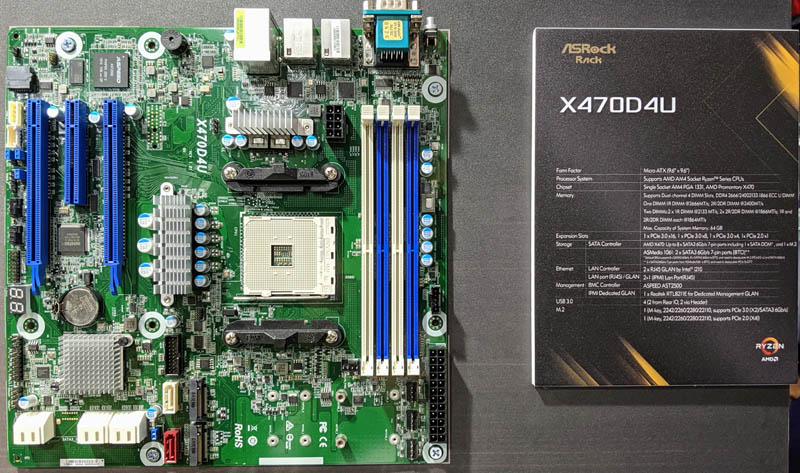
The official CPU support list starts at the Ryzen 2000 series and covers all the way to the top of the 3000 series stack with support for the Ryzen 9 3950X. Officially, this list excludes the first-gen Ryzen 1000 series parts, but I can confirm both the original Ryzen 5 1600 and the Ryzen 5 1600 AF CPU, which is derived from the Zen+ architecture used on the 2000 series CPUs, work without issue. With that information, it is likely the entire Ryzen 1000 line will work as well.
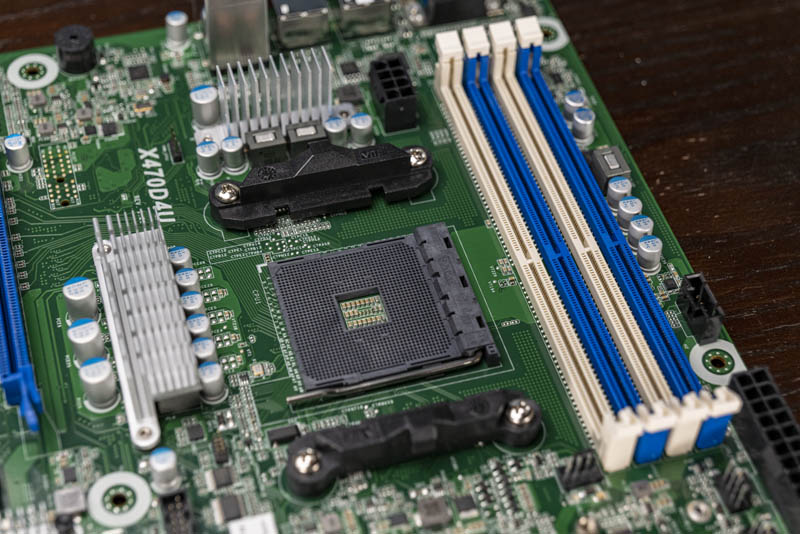
Given the Ryzen CPU, there is dual-channel memory support for up to 4 DDR4 unbuffered DIMMs at speeds up to DDR4-3200. ECC memory support is included, and the relatively new 32GB ECC DDR4 2666 DIMMs are supported, giving a maximum memory capacity of 128GB.
During testing, one problem was encountered with regards to the physical location of the CPU socket in relation to the memory slots. The Ryzen CPU being used for testing was installed with the stock cooler, specifically the AMD Wraith Stealth. The first memory slot on the X470D4U is so close to the CPU socket that it is blocked from use while the Wraith Stealth cooler is installed. The fan on the cooler even makes light contact with the DIMM in the second memory slot.
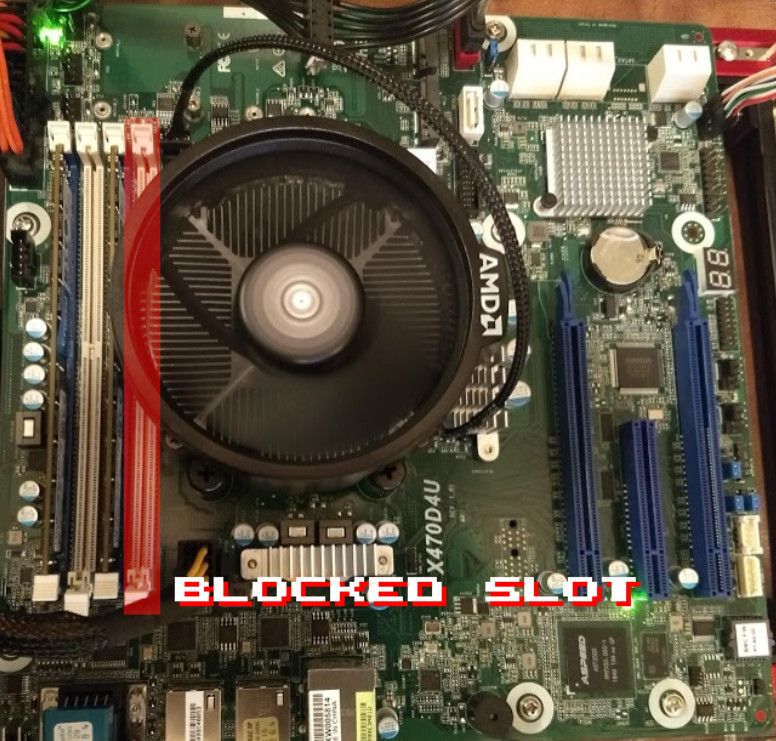
A taller cooler like the Wraith PRISM would not have this problem, but other Ryzen coolers might encounter difficulty. Also, users with taller DIMMs than we tested with will certainly encounter problems with both slots 1 and 2. For typical server-style passive heatsinks this is not an issue, nor is it for ASRock Rack’s pre-validated heatsinks. Still, for those looking to save money and making an inexpensive edge server (e.g. a NAS) with the stock cooler, this is an important challenge to consider.
Based on the X470 chipset, this motherboard is limited to PCIe Gen3, even when populated by a Ryzen 3000 series CPU that would otherwise support Gen4. There are two PCIe x16 slots and an x8 slot. Only the first top x16 slot can operate at x16 link speeds. The second x16 slot is electrically x8, and if both x16 slots are occupied they automatically operate at x8/x8. The x8 slot between them is electrically x4.
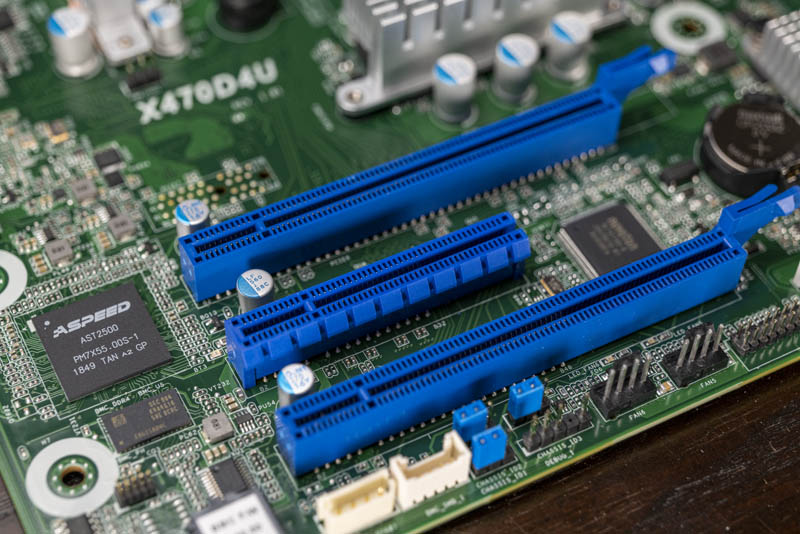
There are also two M.2 slots on board, but neither runs at the maximum PCIe 3.0 x4 speed as you might expect. M2_1 can operate at PCIe 3.0 x2 or SATA3, while M2_2 operates at PCIe 2.0 x4. If you want more PCIe connectivity, we suggest moving to AMD EPYC.
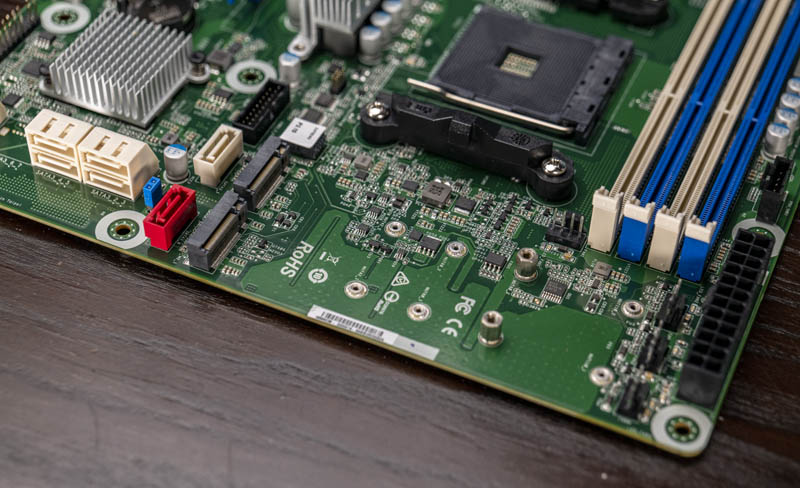
The rest of storage is handled by the 8 onboard SATA3 ports; 6 are provided by the X470 chipset, including one port with support for SATA DOMs. The other 2 SATA3 ports are provided by an Asmedia controller and are not present on the X470D4U2-2T version of this platform.
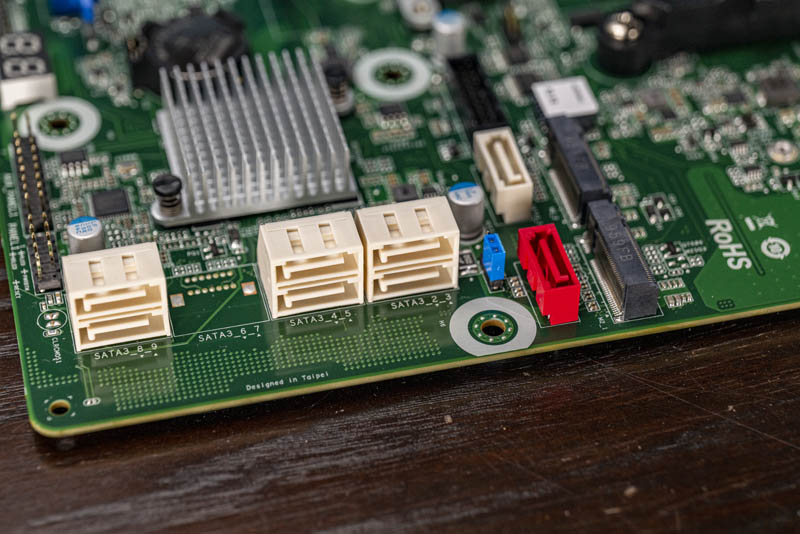
Rear I/O is limited; only two USB 3.0 ports are exposed. There is a serial port as well as a VGA output driven by the ASPEED AST2500. That AST2500 BMC has its own dedicated NIC above the USB ports, and there are two 1GbE connections powered by an Intel i210AT controller.
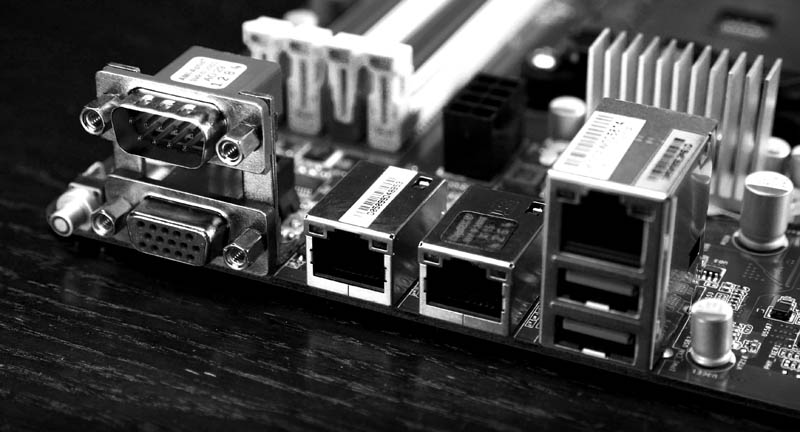
That ASPEED AST2500 is the baseboard management controller and is the defining feature of this motherboard. The BMC will allow out of band management of the system, full remote KVM, and mounting of virtual media over the network. Many of STH’s readers will be familiar with the ASPEED brand of BMC, as it is commonly used on Inspur, Supermicro, Gigabyte, and other vendor boards. Its inclusion on a Ryzen board is very nearly unique at this point in time. If you need IPMI support from a Ryzen-based platform to be able to deploy and manage the server remotely, this ASRock Rack X470D4U is one of the only options around. Coupled with the front to back chassis airflow, these are some of the changes made to turn a Ryzen platform into a server platform.
ASRock Rack X470D4U Topology
We wanted to take a quick moment here to show the system topology. We described it in words above but seeing it helps. First, here is the block diagram:
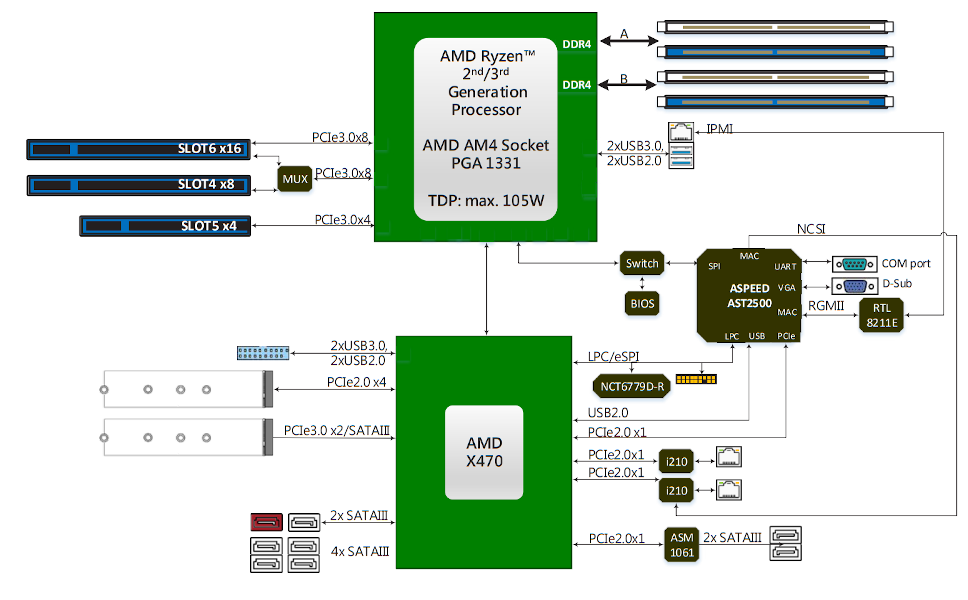
An explanation of that block diagram one can see in our hardware overview above. Here is the topology:
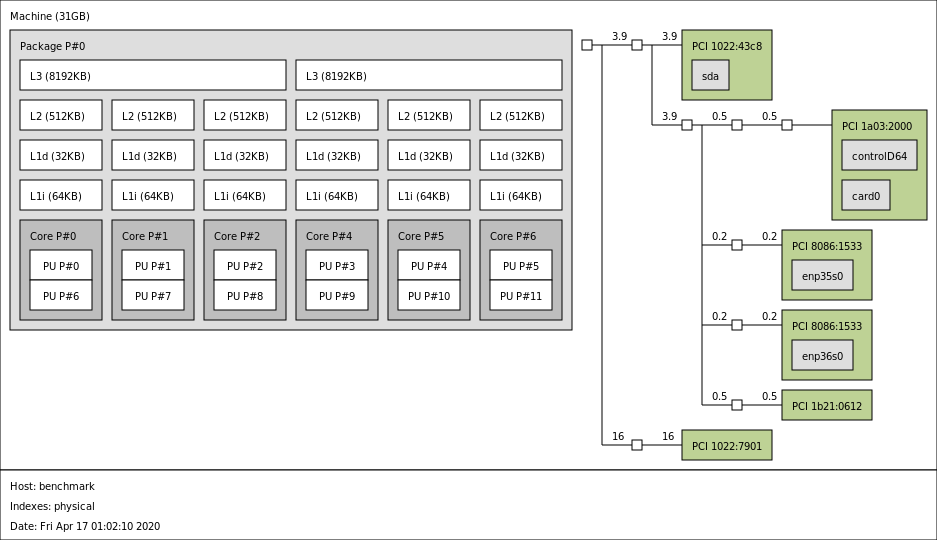
Since this is based on Ryzen, it is a single NUMA node design even when using Zen(+). AMD EPYC 7001 8-core servers, such as those based on the AMD EPYC 7251 had four NUMA nodes which created a lot of inter-die traffic. With Ryzen, one does not have to worry about that these lower-cost platforms.
Next, we are going to look at the CPU options, management, test configuration, and OS testing, before getting to performance and power consumption.

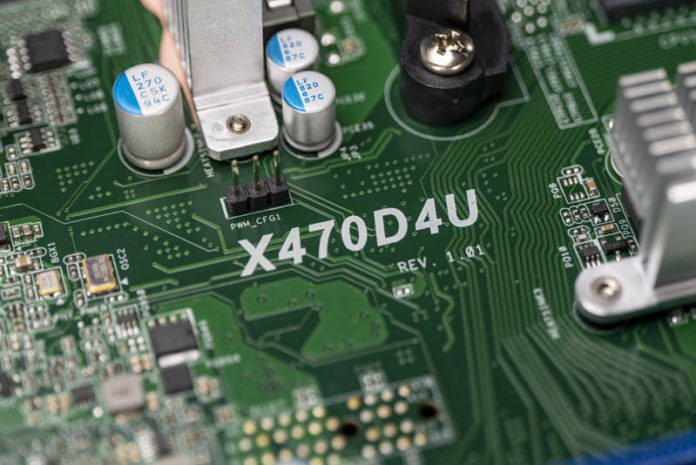



What does certified mean these days in the computer industry when all vendors (incl. Dell, VMWare, HP, Microsoft, etc..) did nothing to prevent us from leaks like Meltdown, foreshadow, spectre, etc… We where all vulnerable for these leaks while using “certified” hard- and software. When we had problems with certified hard- and software we still have to wait for an upcoming solution from the hard- and software vendor.
It makes you wonder why most cloud-providers, streaming services, etc.. use their own hard- and software instead of, of the shelf “certified” hard- and software.
Great review by the way.
We are testing this board for our cloud server environnement since a few weeks now.
We decided to put it to the edge by testing is with the Ryzen 3950X, and we have faced some limitations, we believe the cooling of the vrm’s or the chipset is not good enought to cope when the system is pushed to the edge. (heavy CPU benchmark / stress test).
We have installed an aio watercooling to be sure the cpu was properly cooled and all this fitted in a Supemicro SC933 chassis (which is quite properly equipped in terms of airflow) we still have the speed dropping to 512 Mhz when doing banchmarks with a cpu temperatur stable at 72°.
We will test with a Ryzen 3900X to see if it makes a difference.
This board is part of my homelab (paired with a Ryzen 2700) and has been running Proxmox 24/7 without any issues for ~10 months. It can’t compare to the Epyc platform but is a great product for anyone looking to build a low power/small server. I was more than happy to get rid of my Xeon-D quad core, particularly considering the wealth of Intel exclusive vulnerabilities. Nevertheless, a larger selection of Ryzen (and Epyc!) workstation as well as server boards is long overdue.
Pierre-François Lareppe, I’m quite curious to know about difference between 3950x and 3900x. Looking forward to newer X570D4i-2T board, when it will become available, but I’m also looking for mild overclock if possible.
Thanks for the review Will.
I’m planning to buy this motherboard for my new Home Lab/NAS. Could you give us the exact reference of the Crucial Memory you’ve used ?
Fabian: …exactly same story here. Proxmox running very stable on this (also have 2700). Only problem I found is sometime a weird behavior of remote management which dont allow you to connect.
I had 2x CT16G4XFD8266 in the system for all benchmarks. I also booted it up with some Corsair Vengeance DDR4 3200 desktop memory when I first got the motherboard, but did not have that memory in the system for any of the actual testing.
Thanks Will
I should also state, this board has been running FreeNAS 11.3 for about 10 days now with no issues, doing some other testing. I must have forgotten to list that one in the tested OS list!
“Readers have been asking us to investigate the platform for some time now.”
I was one of those readers. So, thank you very much for the review!
I was thinking of using this as a NAS motherboard using Ryzen Pro and ECC memory. Anyone else doing this configuration?
You dont need Ryzen Pro for working ECC memory. I have standart Ryzen 2700 and ECC working fine.
Xena is correct; the memory I used was ECC enabled for all testing. When I was in Windows initially I verified that ECC support was recognized from within the OS as well. My understanding is that ECC support still depends on the CPU though, and should you install one of the APUs in the system then it would be unsupported.
@Will Thanks for the review. Do you think you could shed more light on the ECC error reporting? We know it works in the host OS but doesn’t on the IPMI. We are missing the exact reason for this.
There is a lot of discussion happening on the level1techs forum but no authoritative answers so far: https://forum.level1techs.com/t/asrock-rack-has-created-the-first-am4-socket-server-boards-x470d4u-x470d4u2-2t/139490/
@Xena Strange, my BMC never showed such a behavior – however some sensor data is wrong.
@David As others have already explained any Ryzen CPU supports ECC. A set of Samsung M391A2K43BB1-CTD is working flawlessly in my setup.
@Remisc, I’ll admit to not quite following along with the idea that ECC is “working in the host OS but doesn’t on the IPMI”. That thread you linked is 1100 posts long and in no way focused on a single issue. If you can clarify for me, I’d be happy to investigate on my end as I am still in possession of the board. You can send me whatever you’ve got to will.taillac@gmail.com and I’ll do my best to look into it!
@Fabian, *almost* any Ryzen CPU. The Ryzen APUs do *not* support ECC memory, regardless of motherboard, though I have been led to believe the Ryzen Pro APUs *do* support ECC. I haven’t tested either personally though; I have literally never touched a Ryzen APU.
@Pierre
Check your ipmi log and see if cpu proc hot state is asserted.
There’s a bug with this board for certain kinds of psus trigger this and throttle the cpu even though the cpu is adequately cooled. Check out the following forums posts
https://forum.level1techs.com/t/asrock-rack-has-created-the-first-am4-socket-server-boards-x470d4u-x470d4u2-2t/139490/17
The only downside I’ve seen using VMWare is that I cannot use this board to make a cluster with EVC enabled.
So you will not be able to use this board with a Zen3 CPU. How do you feel about that?
Nikolay,
In general, I’m disappointed that the 400 series chipsets aren’t going to be compatible with Zen3. More than that, though, I think AMD bungled the process of releasing that information.
Specific to this motherboard, though, I find myself less bothered / affected. In my experience, servers are often purchased for a specific reason – to host a specific application, or database, or whatever. Most of the servers I’ve been responsible for over the years never receive new hardware for their entire lifetime unless it is in response to a component failure or simply adding storage into previously empty bays. Most of my customers would be unlikely to swap a Ryzen 3600 out of a server and replace it with a 4600 (or whatever it ends up called) down the line; our more typical upgrade process would tend to be replacing an entire server, which allows the old system and new to coexist for the migration period.
Got two of these in my homelab setup. One with a 2700 and the other with a 3900X, both with maxed out ram and running vmware 6.7. Rock solid boards with good expansion options.
I deployed this board for my home server with Proxmox. I am using a Ryzen 7 3700x, 64gb of GSKILL AEGIS DDR4 3000mhz RAM. It’s been running for a week now without a hiccup. I bought it primarily for the IPMI functionality, which as Will’s review states, is very rough around the edges. I gave up on BMC mounted ISO install as it was horribly slow. The lack of USB connectivity stinks, but a $15 USB hub fixed that. Would I buy this board again? That’s a solid no. It provides very little value at it’s $250 price point. I would return the board, but as of May 19th 2020, there’s a shortage of X570/X470 boards due to Covid-19, and the MSI MEG X570 Unify that I would like to replace it with is about a month out for delivery. Great review!!
I’m debating installing one of these into an older Supermicro Opteron 1U chassis (813M-3), but I don’t see a good option for cooling it. I only see 2 1U AM4 coolers out there; a Dynatron with a blower fan that *might* work but gets bad reviews for early fan failures and a Noctua with a “normal” fan that would be trying to pull air through the metal lid on the case. The Dynatron’s heatsink looks like it’s oriented correctly for the system fans to do their thing, but it’s not very tall. The Noctua looks like it’d be oriented sideways, so it basically wouldn’t cool at all.
Has anyone had any success with the X470D4U in 1U?
Nice write up Will. You bring up the CPU cooler intruding on the RAM sockets, could you measure that distance? It would be helpful in qualifying what coolers would be more compatible with that board.
Are there still stocks of this board anywhere around? I didn’t find some. Anyway, why should there be some? A similar board based on the B550 chipset would be really beautiful, and not a single person would buy this one anymore. I’m looking forward for such an updated board myself, to build a small edge server.
Mike,
Mind you I don’t have exact measuring tools like calipers or anything, but I’ve got your basic measuring tape and the distance from socket to slot seems to be 1.4 cm. Pardon the MS Paint level visual aid, but here you go: https://i.imgur.com/RVTvU6n.png
Also, AMD today reversed course on the 400 series Zen3 lockout, so there is a very real possibility this board will receive Zen3 support in the future!
Will – Regarding ECC functionality and testing, to my understandig the ECC issue with this board boils down to this: When trying to verify ECC actually works do you see ECC related events (correctable error, …) in the System/IPMI event log? If yes how did you do it?
I’ve just replaced an old Supermicro X9SCL +E3 1220v2 with one of these boards and a 3700X. All in all, very impressed with this for a SOHO / Prosumer setup, and has been completely stable for the last two months. I bought primarily for the IPMI access – there was nothing Intel based that could touch this on price/performance – apart from there being no supply of the latest Xeon 2246 in the UK even if I wanted to go the Intel route.
Definitely would recommend for home use:
– Performance / stability great – Mine is running Linux with a number of VMs
– CPU cooler clearance / Slot 1 – Using a Noctura profile HSF and no issues with that
– I’ve installed my own HBA and Intel 10G interfaces – the box happily serving up 7Gbit/s of data
A few points to add to the review :
– The board is in very short supply – mine came in from the US to the UK via NewEgg, there was no EU stock. The newer X570 rumored to be available soon is Micro ATX missing the PCI-E expansion slots of this one – for me, a non-starter.
– BIOS is bare bones and difficult to navigate ( eg to force memory to run @ DDR3200 ). Maybe as I’m not so familiar with AMD kit vs Intel on Supermicro /Dell / HP ?
– IPMI works well. Performance for remote mounting of ISOs to boot from is unfair in the review – it is actually better than both HP Gen8 server ( ~10Mbs ) and a Supermicro X10 board I’m working on right now remotely rebuilding (7Mbps) – It is a non issue for me if it lets me work remotely.
IMO – this board if you can get it makes a great VFM home server.
@Scott Laird – I’m using this cooler: https://noctua.at/en/nh-l9a-am4 with a 65W 3700x and it works fine in the case I have with limited clearance. If you’re using 1U with some fans and can route some air through / past that would also work – the Heatsink is open on two sides so if you can route air to flow through you should be fine.
Ben F,
BIOS did seem somewhat barebones, but there were memory speed options buried in there if I remember correctly. I found them when making sure my test memory was running at 2666.
As for IPMI speed, I use Supermicro kit very commonly and the slow remote media is something I am not used to. On Supermicro I’ve seen slow media before, but only when using the shared NIC; the dedicated NIC has always been much faster. For the X470D4U, it was slow on both, though even more so when using the shared NIC. My screenshot and installation time complaint was when using the dedicated NIC, and thus represents a best case scenario.
This article mentions “pre-validated heatsinks”. Does anyone know where to find that list? I’m thinking about this board in a 2U case like the SilverStone RM21-308. Would love any recommendations for good 2U CPU coolers that will allow access to all of the memory slots.
I think they’re talking about the heatsinks that are validated by coming in servers ASRR makes.
Can confirm FreeBSD runs fine, and stuff in the RedHat tree (CentOS 8, Fedora) does
as well. :)
It’s good to know I didn’t waste the performance of the M.2 slots with Intel 660p drives.
It would have been nice to see the storage subsystems tested. Especially since everything is kind of a grab bag. Two different SATA controllers? Which one is better, and is there a drop in performance when they are mixed in a RAID setup? Same thing with the M.2 slots and their odd PCIe standard mixture.
Anyway, this is great little board for low end servers. SOHOs and prosumers would be very happy with this board.
Does the PCIe slot 6 support x8/8 bifurcation? It’s difficult to find any AMD motherboards with support for x8/8 bifurcation.
1X0r1, I still have the board plugged in. When it is done with its current test, I will see if anything regarding bifurcation is mentioned in the BIOS. Of course, x8/x8 splitting of the lane is automatically achieved between slots 6 and 4, so I’m doubtful that it will be supported on just PCIE6, but if I find any indications otherwise I will update you.
@Druid, I’m also running FreeBSD (12.1) on this board. I got the Asmedia controller to stall/hang when transfering files to a zfs mirror attached to it. Source drives were connected to the other sata controller. I think it was around 1TB data that was intended to be transfered. Running a scrub on data that had been transfered didn’t detect any errors.
I purchased a HBA an stopped using the Asmedia ports. Maybe the stall/hang is related to the FreeBSD driver. Can’t remember if I was running 12.0 at the time of trying the filetransfer.
I’m planning a build for a replacement home server. The plan so far is to go with this mobo and the 3700x with 4x32GB. Does the stock cooler (Wraith Prism) that comes with the 3700X (it is only 65W TDP) block the DIMMs? The review suggests it won’t be an issue, but I’d like to be sure. Also, any illumos users of this board here? I’ll be running OmniOSce.
Dan,
It does not. My personal computer has a 3700X and I never used the cooler, so I had it on hand when testing this board. It looked fine!
So just drop in the 3700X, not even with the in-box cooler? Just making sure I understand…
Sorry, let me clarify. My personal desktop has a 3700X, but I used an aftermarket cooler. As a result, I have the Wraith Spire cooler sitting handy right next to me, and I was able to check it against the socket on the X470D4U. I didn’t fully clamp it down, but it looked like it was going to fit no big deal!
I think there is pretty huge demand for this (and hopefully more similar) products. The gamer oriented market for motherboards is pretty flooded with huge variety and choices, whereas for the tinkerers/home server enthusiasts this motherboard, with IPMI and ECC support but otherwise consumer price point and features make a hugely compelling option.
I’m sure there are a lot of people like me who grew up gamers but now primarily need something that is capable and stable and just works, that we can tinker with even from afar…
To some extent the problem is that Intel dropped the ball with their VPro platform and their dreaded segmentation – only fairly recently is there a free software option for remotely managing systems with VPro, and building your own system with VPro is like solving a complicated series of riddles… which cpu, which chipset, which board etc.
Of course with the explosion in the number of cores offered, this motherboard is hugely compelling as a drop in upgrade for servers perhaps a few years old, with huge power savings and speed gains available for much less then a new server would cost.
We upgraded a couple of old dual socket xeon systems at work with this motherboards close relative, the x399d8a-2t and TR 1920x processors – the added expansion capacity was a bit too attractive to pass up – and we’ve been very happy.
Very tempted to get one of these as a workstation, just need to decide if I can justify it!
1.) Will, thank you. (And you meant to say prism, not spire, right?)
2.) I’m far less concerned about IPMI than I am about lower wattage and ECC support. I’m planning “Home Data Center 3.0”, and what I have works… I just want more now. Prior HDC details (for reference) are here: https://kebesays.blogspot.com/2014/06/home-data-center-20-dogfooding-again.html
Dan,
1- Yes, I meant Prism!
2- For super low wattage systems, I think there are better platforms, based on Epyc 3000 or Xeon D. If performance is still a key metric, or perf-per-watt, then I think the X470D4U represents an intriguing option.
Just for what it is worth, the fan blades on the box cooler do in fact clear the RAM, so I removed the shroud and cut the frame a little bit and I have been successfully been able to use it without any issues.
Really annoying, however.
@Pierre-François Lareppe
Maybe try with Arctic Liquid Freezer II AiO, which comes with an extra fan for VRM cooling. GamersNexus tested it and found it effective in reducing VRM temperature.
I’m running this board with a Ryzen 5 3600X, 64GB ECC RAM and FreeNAS 11.3 for about a month now, no issues at all and seems very stable.
Excellent reviews
Can you anyone if this board will work with the 3950x and ecc ram. Secondly will it work with m.2 raid0?
What I’m looking forward to see is a review of the 1U4LW-X470
There is definitely a market for this, as I have several virtual host servers that I would love to install for a better price point than the EPYC systems, and won’t need much more than 128GB or the I/O lanes allocated to the Ryzen.
Has anyone run ESXi 7.0 on this board, it appears the networking should be compatible. I’d also like to know if anyone using vmware has been able to pass thru Drives to a Freenas VM or other storage appliance. I’m very tempted to purchase this for my home lab, but hard to find much info on it.
@Alexandru
I have this board (X470D4U2-2T version) running with 3950X & 128GB ECC, Windows Server 2019 standard.
4 X KINGSTON 32GB 3200MHz DDR4 ECC CL22 DIMM (KSM32ED8/32ME)
Memory runs 2400MHz with 4 sticks, 3200MHz with 2 sticks.
OS sees ECC (wmic memphysical get memoryerrorcorrection gives result 6 Multi-bit ECC)
Bios is 3.30, running with default settings, only change is running PPT @88W so CPU is now about 65W.
I have 4 NVME PCIE SSDs on ASUS HYPER M.2 X16 GEN 4 CARD for Hyper-V guests. I have tested windows softraid & storage spaces. But not onboard RAID (soft/biosraid).
Regarding the Arctic Liquid Freezer II AiO cooler recommendation in this thread:
I got this cooler and it BARELY fits. The mount is within a millimeter (max 2mm) of the RAM. It will not work with RAM that has heatsinks. I got NEMIX RAM 32GB Replacement for Samsung M391A4G43MB1-CTD DDR4-2666 ECC UDIMM 2Rx8 which works great, and the mount is basically touching the memory chips. Cooler works fantastic on a 5950x.
Regarding the CPU_PROCHOT being thrown:
It’s possibly not a “bug” and you just need better cooling. In windows I checked HWInfo and Thermal Throttling (HTC) + Thermal Throttling (PROCHOT EXT) were being triggered, which signifies it’s something on the board (not the CPU) that was getting too hot. Added another fan to my case and this fixed that problem.
Fantastic write-up! The ASRock Rack X470D4U seems like an ideal option for small businesses or home labs that need server-grade performance without breaking the bank. I love how the board supports both Ryzen processors and ECC memory—perfect for those who want stability and reliability. One thing I’d be curious about: how does the board handle thermal performance under heavy load? I’ve heard great things about ASRock Rack’s cooling solutions, but it’d be great to hear your thoughts on real-world performance. Keep up the great work!
Keep up the great work, and I am eager to read more from you in the future.